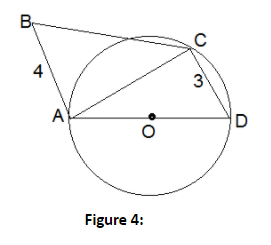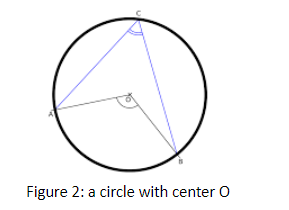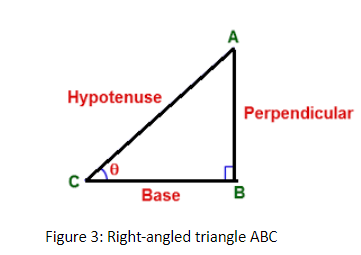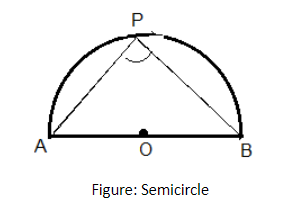
In the figure, if the triangle$\vartriangle ABC$ is an isosceles triangle of perimeter 20, calculate the approximate area of the circle with center O.

A) 26.83
B) 33.65
C) 44.17
D) 57.33

Answer
577.8k+ views
Hint: The radius of the circle is needed to find the area of the circle. In an isosceles triangle, the length of the two sides is equal.
A circle is a collection of all the points from a fixed point, at a fixed distance. The fixed point is called the center. The fixed distance from the center is called the radius $r$.
The relation between diameter and radius of the circle: diameter is twice of radius
Pythagoras theorem can be applied to every right angle triangle. The angle between two adjacent sides of a rectangle is $90^\circ $.
In a right-angled triangle, the base and perpendicular are at the angle of $90^\circ $ each other, and hypotenuse is the longest side.
Complete step by step solution:
Step 1: Draw the given figure

Step 2: given that
$\vartriangle ABC$is an isosceles triangle
Hence, BC = AC …… (1)
AB = 4 cm …… (2)
The perimeter of the triangle$\vartriangle ABC$= 20
Step 3: use the perimeter of the triangle to find length AC:
The perimeter of a triangle is equal to the sum of the length of all three sides of the triangle.
In $\vartriangle ABC$, perimeter is equal to AB + BC + AC = 20
4 + AC + AC = 20 (from (1) and (2))
$
2AC = 20 - 4 \\
{\text{ }}AC = \dfrac{{16}}{2} \\
$
AC = 8 cm …… (3)
Step 4: use the below theorem to find $\angle ACD$
Theorem 1: The angle subtended by an arc at the center is double the angle subtended by it at any point on the remaining part of the circle.

In the above circle, $\angle AOB = 2(\angle ACB)$
In the given circle with center O,
Chord AD is a diameter, as it is passing through the center.
$\angle AOD = 180^\circ $ ($\because $AOD is a straight line)
According to theorem 1:
$\angle AOD = 2(\angle ACD)$
$
\Rightarrow \angle ACD = \dfrac{{\angle AOD}}{2} \\
{\text{ = }}\dfrac{{180^\circ }}{2} \\
{\text{ = 90}}^\circ \\
$
Step 5: find the length AD using Pythagoras theorem
Pythagoras theorem: square of the hypotenuse is equal to the sum of the square of base and square of perpendicular.

$\mathop {{\text{Hypotenuse}}}\nolimits^{\text{2}} {\text{ = }}\mathop {{\text{ Base}}}\nolimits^{{\text{2 }}} {\text{ + }}\mathop {{\text{ Perpendicular}}}\nolimits^{\text{2}} $
$\vartriangle ACD$ is a right angle triangle, right-angled at C.
Using Pythagoras theorem on $\vartriangle ACD$
$\mathop {{\text{Hypotenuse}}}\nolimits^{\text{2}} {\text{ = }}\mathop {{\text{ Base}}}\nolimits^{{\text{2 }}} {\text{ + }}\mathop {{\text{ Perpendicular}}}\nolimits^{\text{2}} $
$\mathop {{\text{AC}}}\nolimits^2 + \mathop {{\text{CD}}}\nolimits^{\text{2}} {\text{ }} = {\text{ }}\mathop {{\text{AD}}}\nolimits^{\text{2}} $
$\mathop { \Rightarrow {\text{ 8}}}\nolimits^{\text{2}} + \mathop 3\nolimits^{\text{2}} {\text{ }} = {\text{ }}\mathop {{\text{AD}}}\nolimits^2 $ (from (3) and given)
$ \Rightarrow 64 + 9{\text{ }} = {\text{ }}\mathop {{\text{AD}}}\nolimits^2 $
\[ \Rightarrow \mathop {{\text{ AD}}}\nolimits^{\text{2}} = 73\]
\[ \Rightarrow {\text{AD = }}\sqrt {73} \]cm
${\text{AD }} \approx {\text{ 8}}{\text{.54 cm}}$ …… (4)
Step 7: find OD
We know, the diameter is twice of radius
$
{\text{ }}d = 2r \\
{\text{ AD = 2}} \cdot {\text{OD}} \\
{\text{ 8}}{\text{.54 = 2}} \cdot {\text{OD}} \\
{\text{ OD = }}\dfrac{{8.54}}{2} \\
$
Radius, r, OD = 4.27 cm
Step 8: Find the required area of the circle.
Area of circle $ = \pi \mathop r\nolimits^2 $
$
= 3.14 \times \mathop {4.27}\nolimits^2 \\
= 57.25 \\
$
$ \approx 57.33$sq. units
The area of the given circle is 57.33 sq. units. The correct option is (D).
Note:
The perimeter of the circle is $2\pi r$units.
The angle in a semicircle is a right angle.

Consider point P at on the semicircle.
Line AB is the diameter of the semicircle with center O
Hence, $\angle AOB = 180^\circ $
Thus, using the theorem 1:
$
\angle APB = \dfrac{1}{2}\angle AOB \\
\Rightarrow {\text{ }} = \dfrac{1}{2}\left( {180^\circ } \right) \\
$
Thus, $\angle APB = {90^ \circ }$
Do not expect the question will only be solved on one concept. Focus on all the given information, the approach of the solution lies within.
A circle is a collection of all the points from a fixed point, at a fixed distance. The fixed point is called the center. The fixed distance from the center is called the radius $r$.
The relation between diameter and radius of the circle: diameter is twice of radius
Pythagoras theorem can be applied to every right angle triangle. The angle between two adjacent sides of a rectangle is $90^\circ $.
In a right-angled triangle, the base and perpendicular are at the angle of $90^\circ $ each other, and hypotenuse is the longest side.
Complete step by step solution:
Step 1: Draw the given figure

Step 2: given that
$\vartriangle ABC$is an isosceles triangle
Hence, BC = AC …… (1)
AB = 4 cm …… (2)
The perimeter of the triangle$\vartriangle ABC$= 20
Step 3: use the perimeter of the triangle to find length AC:
The perimeter of a triangle is equal to the sum of the length of all three sides of the triangle.
In $\vartriangle ABC$, perimeter is equal to AB + BC + AC = 20
4 + AC + AC = 20 (from (1) and (2))
$
2AC = 20 - 4 \\
{\text{ }}AC = \dfrac{{16}}{2} \\
$
AC = 8 cm …… (3)
Step 4: use the below theorem to find $\angle ACD$
Theorem 1: The angle subtended by an arc at the center is double the angle subtended by it at any point on the remaining part of the circle.

In the above circle, $\angle AOB = 2(\angle ACB)$
In the given circle with center O,
Chord AD is a diameter, as it is passing through the center.
$\angle AOD = 180^\circ $ ($\because $AOD is a straight line)
According to theorem 1:
$\angle AOD = 2(\angle ACD)$
$
\Rightarrow \angle ACD = \dfrac{{\angle AOD}}{2} \\
{\text{ = }}\dfrac{{180^\circ }}{2} \\
{\text{ = 90}}^\circ \\
$
Step 5: find the length AD using Pythagoras theorem
Pythagoras theorem: square of the hypotenuse is equal to the sum of the square of base and square of perpendicular.

$\mathop {{\text{Hypotenuse}}}\nolimits^{\text{2}} {\text{ = }}\mathop {{\text{ Base}}}\nolimits^{{\text{2 }}} {\text{ + }}\mathop {{\text{ Perpendicular}}}\nolimits^{\text{2}} $
$\vartriangle ACD$ is a right angle triangle, right-angled at C.
Using Pythagoras theorem on $\vartriangle ACD$
$\mathop {{\text{Hypotenuse}}}\nolimits^{\text{2}} {\text{ = }}\mathop {{\text{ Base}}}\nolimits^{{\text{2 }}} {\text{ + }}\mathop {{\text{ Perpendicular}}}\nolimits^{\text{2}} $
$\mathop {{\text{AC}}}\nolimits^2 + \mathop {{\text{CD}}}\nolimits^{\text{2}} {\text{ }} = {\text{ }}\mathop {{\text{AD}}}\nolimits^{\text{2}} $
$\mathop { \Rightarrow {\text{ 8}}}\nolimits^{\text{2}} + \mathop 3\nolimits^{\text{2}} {\text{ }} = {\text{ }}\mathop {{\text{AD}}}\nolimits^2 $ (from (3) and given)
$ \Rightarrow 64 + 9{\text{ }} = {\text{ }}\mathop {{\text{AD}}}\nolimits^2 $
\[ \Rightarrow \mathop {{\text{ AD}}}\nolimits^{\text{2}} = 73\]
\[ \Rightarrow {\text{AD = }}\sqrt {73} \]cm
${\text{AD }} \approx {\text{ 8}}{\text{.54 cm}}$ …… (4)
Step 7: find OD
We know, the diameter is twice of radius
$
{\text{ }}d = 2r \\
{\text{ AD = 2}} \cdot {\text{OD}} \\
{\text{ 8}}{\text{.54 = 2}} \cdot {\text{OD}} \\
{\text{ OD = }}\dfrac{{8.54}}{2} \\
$
Radius, r, OD = 4.27 cm
Step 8: Find the required area of the circle.
Area of circle $ = \pi \mathop r\nolimits^2 $
$
= 3.14 \times \mathop {4.27}\nolimits^2 \\
= 57.25 \\
$
$ \approx 57.33$sq. units
The area of the given circle is 57.33 sq. units. The correct option is (D).
Note:
The perimeter of the circle is $2\pi r$units.
The angle in a semicircle is a right angle.

Consider point P at on the semicircle.
Line AB is the diameter of the semicircle with center O
Hence, $\angle AOB = 180^\circ $
Thus, using the theorem 1:
$
\angle APB = \dfrac{1}{2}\angle AOB \\
\Rightarrow {\text{ }} = \dfrac{1}{2}\left( {180^\circ } \right) \\
$
Thus, $\angle APB = {90^ \circ }$
Do not expect the question will only be solved on one concept. Focus on all the given information, the approach of the solution lies within.
Recently Updated Pages
Two men on either side of the cliff 90m height observe class 10 maths CBSE

What happens to glucose which enters nephron along class 10 biology CBSE

Cutting of the Chinese melon means A The business and class 10 social science CBSE

Write a dialogue with at least ten utterances between class 10 english CBSE

Show an aquatic food chain using the following organisms class 10 biology CBSE

A circle is inscribed in an equilateral triangle and class 10 maths CBSE

Trending doubts
Why is there a time difference of about 5 hours between class 10 social science CBSE

Write a letter to the principal requesting him to grant class 10 english CBSE

What is the median of the first 10 natural numbers class 10 maths CBSE

The Equation xxx + 2 is Satisfied when x is Equal to Class 10 Maths

Which of the following does not have a fundamental class 10 physics CBSE

State and prove converse of BPT Basic Proportionality class 10 maths CBSE




